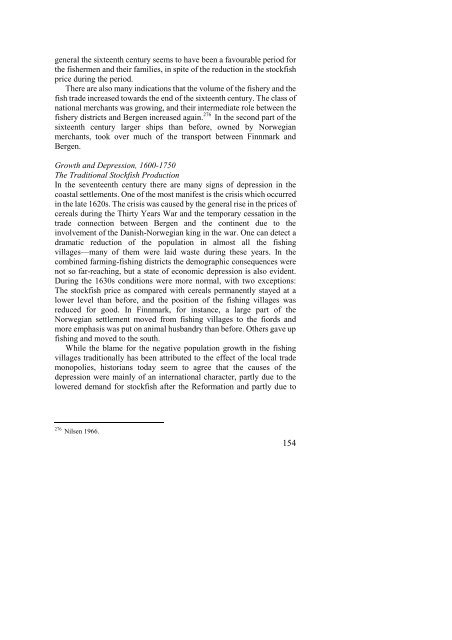The North Atlantic Fisheries, 1100-1976 - University of Hull
The North Atlantic Fisheries, 1100-1976 - University of Hull
The North Atlantic Fisheries, 1100-1976 - University of Hull
You also want an ePaper? Increase the reach of your titles
YUMPU automatically turns print PDFs into web optimized ePapers that Google loves.
general the sixteenth century seems to have been a favourable period for<br />
the fishermen and their families, in spite <strong>of</strong> the reduction in the stockfish<br />
price during the period.<br />
<strong>The</strong>re are also many indications that the volume <strong>of</strong> the fishery and the<br />
fish trade increased towards the end <strong>of</strong> the sixteenth century. <strong>The</strong> class <strong>of</strong><br />
national merchants was growing, and their intermediate role between the<br />
fishery districts and Bergen increased again. 276 In the second part <strong>of</strong> the<br />
sixteenth century larger ships than before, owned by Norwegian<br />
merchants, took over much <strong>of</strong> the transport between Finnmark and<br />
Bergen.<br />
Growth and Depression, 1600-1750<br />
<strong>The</strong> Traditional Stockfish Production<br />
In the seventeenth century there are many signs <strong>of</strong> depression in the<br />
coastal settlements. One <strong>of</strong> the most manifest is the crisis which occurred<br />
in the late 1620s. <strong>The</strong> crisis was caused by the general rise in the prices <strong>of</strong><br />
cereals during the Thirty Years War and the temporary cessation in the<br />
trade connection between Bergen and the continent due to the<br />
involvement <strong>of</strong> the Danish-Norwegian king in the war. One can detect a<br />
dramatic reduction <strong>of</strong> the population in almost all the fishing<br />
villages—many <strong>of</strong> them were laid waste during these years. In the<br />
combined farming-fishing districts the demographic consequences were<br />
not so far-reaching, but a state <strong>of</strong> economic depression is also evident.<br />
During the 1630s conditions were more normal, with two exceptions:<br />
<strong>The</strong> stockfish price as compared with cereals permanently stayed at a<br />
lower level than before, and the position <strong>of</strong> the fishing villages was<br />
reduced for good. In Finnmark, for instance, a large part <strong>of</strong> the<br />
Norwegian settlement moved from fishing villages to the fiords and<br />
more emphasis was put on animal husbandry than before. Others gave up<br />
fishing and moved to the south.<br />
While the blame for the negative population growth in the fishing<br />
villages traditionally has been attributed to the effect <strong>of</strong> the local trade<br />
monopolies, historians today seem to agree that the causes <strong>of</strong> the<br />
depression were mainly <strong>of</strong> an international character, partly due to the<br />
lowered demand for stockfish after the Reformation and partly due to<br />
276 Nilsen 1966.<br />
154















